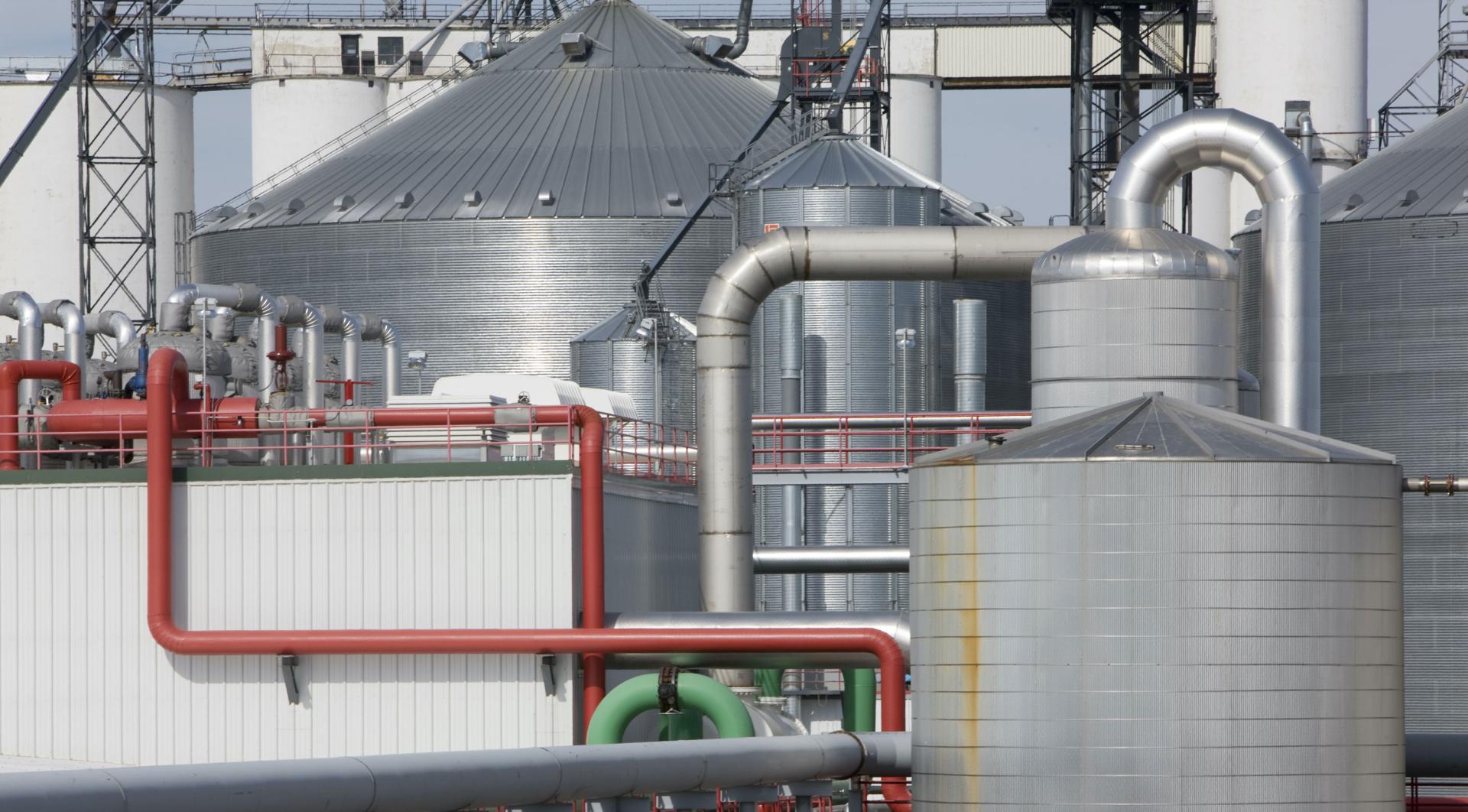Manufacturing
Water is used in many manufacturing processes. During drought conditions, reductions in or interruption of the water supply can result in a reduction of plant productivity or even closure of manufacturing facilities. Integrating drought and extreme weather events into routine business planning can allow manufacturers and communities to proactively prepare system responses before the onset of a drought disaster.
The U.S. Department of Agriculture's (USDA's) National Agricultural Statistics Service (NASS) conducts hundreds of surveys every year and prepares reports covering virtually every aspect of U.S. agriculture, including agricultural commodities statistics for crops (e.g., cotton, soybean, flax) that are important to manufacturing processes.
This map displays USDA cotton crop production (data from 2017) alongside current U.S. Drought Monitor drought designations. Learn more.
This map displays USDA soybean crop production (data from 2017) alongside current U.S. Drought Monitor drought designations. Learn more.
This map displays USDA flax crop production (data from 2017) alongside current U.S. Drought Monitor drought designations. Learn more.
Drought can reduce the water availability and water quality necessary for productive farms, ranches, and grazing lands, resulting in significant negative direct and indirect economic impacts to the agricultural sector. Monitoring agricultural drought typically focuses on examining levels of precipitation, evaporative demand, soil moisture, and surface/groundwater quantity and quality.
Learn MoreWater is used in many manufacturing processes. During drought conditions, reductions in or interruption of the water supply can result in a reduction of plant productivity or even closure of manufacturing facilities. Integrating drought and extreme weather events into routine business planning can allow manufacturers and communities to proactively prepare for drought.
Learn MoreDrought can reduce the water availability and water quality necessary for productive farms, ranches, and grazing lands, resulting in significant negative direct and indirect economic impacts to the agricultural sector. Monitoring agricultural drought typically focuses on examining levels of precipitation, evaporative demand, soil moisture, and surface/groundwater quantity and quality.
Learn MoreWater is used in many manufacturing processes. During drought conditions, reductions in or interruption of the water supply can result in a reduction of plant productivity or even closure of manufacturing facilities. Integrating drought and extreme weather events into routine business planning can allow manufacturers and communities to proactively prepare for drought.
Learn MoreDrought can reduce the water availability and water quality necessary for productive farms, ranches, and grazing lands, resulting in significant negative direct and indirect economic impacts to the agricultural sector. Monitoring agricultural drought typically focuses on examining levels of precipitation, evaporative demand, soil moisture, and surface/groundwater quantity and quality.
Learn MoreWater is used in many manufacturing processes. During drought conditions, reductions in or interruption of the water supply can result in a reduction of plant productivity or even closure of manufacturing facilities. Integrating drought and extreme weather events into routine business planning can allow manufacturers and communities to proactively prepare for drought.
Learn MoreCotton Produced by County
U.S. Drought Monitor
Soybeans Produced by County
U.S. Drought Monitor
Flax Produced by County
U.S. Drought Monitor
The U.S. Department of Agriculture's (USDA's) National Agricultural Statistics Service (NASS) conducts hundreds of surveys every year and prepares reports covering virtually every aspect of U.S. agriculture, including agricultural commodities statistics for crops (e.g., cotton, soybean, flax) that are important to manufacturing processes.
This map displays USDA cotton crop production (data from 2017) alongside current U.S. Drought Monitor drought designations. Learn more.
This map displays USDA soybean crop production (data from 2017) alongside current U.S. Drought Monitor drought designations. Learn more.
This map displays USDA flax crop production (data from 2017) alongside current U.S. Drought Monitor drought designations. Learn more.
Drought can reduce the water availability and water quality necessary for productive farms, ranches, and grazing lands, resulting in significant negative direct and indirect economic impacts to the agricultural sector. Monitoring agricultural drought typically focuses on examining levels of precipitation, evaporative demand, soil moisture, and surface/groundwater quantity and quality.
Learn MoreWater is used in many manufacturing processes. During drought conditions, reductions in or interruption of the water supply can result in a reduction of plant productivity or even closure of manufacturing facilities. Integrating drought and extreme weather events into routine business planning can allow manufacturers and communities to proactively prepare for drought.
Learn MoreDrought can reduce the water availability and water quality necessary for productive farms, ranches, and grazing lands, resulting in significant negative direct and indirect economic impacts to the agricultural sector. Monitoring agricultural drought typically focuses on examining levels of precipitation, evaporative demand, soil moisture, and surface/groundwater quantity and quality.
Learn MoreWater is used in many manufacturing processes. During drought conditions, reductions in or interruption of the water supply can result in a reduction of plant productivity or even closure of manufacturing facilities. Integrating drought and extreme weather events into routine business planning can allow manufacturers and communities to proactively prepare for drought.
Learn MoreDrought can reduce the water availability and water quality necessary for productive farms, ranches, and grazing lands, resulting in significant negative direct and indirect economic impacts to the agricultural sector. Monitoring agricultural drought typically focuses on examining levels of precipitation, evaporative demand, soil moisture, and surface/groundwater quantity and quality.
Learn MoreWater is used in many manufacturing processes. During drought conditions, reductions in or interruption of the water supply can result in a reduction of plant productivity or even closure of manufacturing facilities. Integrating drought and extreme weather events into routine business planning can allow manufacturers and communities to proactively prepare for drought.
Learn MoreWater Supply
Reduction in or interruption of the water supply could lead to lower productivity or closure of manufacturing facilities. Preventative measures such as water audits can help stakeholders understand facility water use and identify best management practices to use water most efficiently.
Planning
Including drought mitigation and prevention measures into planning processes allows manufacturers and communities to develop system responses before the onset of a water shortage.
Drought Impacts on Manufacturing
Manufacturers use water for many processes, including fabrication, processing, washing, diluting, cooling, and transporting goods. Water is also often incorporated into products themselves. High volumes of water are used in the production of food, paper, and chemicals and in the refining of petroleum. Conducting a water assessment of a manufacturing facility is an important first step to understanding facility water use and identifying savings opportunities, before a drought hits.
During drought conditions, reductions in the amount of available water can reduce manufacturing productivity or even lead to temporary closures of key manufacturing facilities. Including drought mitigation and preparation into routine business planning processes can help raise the topic for discussion and allow manufacturers to consolidate resources and develop system responses before a drought event hits. Integrated planning of multiple potential hazards can also help a business to increase resilience and more rapidly recover from drought conditions.
During drought, alternative water supply sources for manufacturing may include groundwater pumping and/or using reclaimed, recycled, or recirculated water.
Drought Early Warning for the Manufacturing Sector
Drought early warning is essential to prepare for and mitigate drought’s impacts on the manufacturing sector. The resources below are organized by the key components of a drought early warning system: (1) drought observation and monitoring; (2) drought planning and preparedness; (3) prediction and forecasting of drought; (4) communication and outreach to the public and affected sectors; and (5) interdisciplinary and applied research on topics of concern to drought-affected sectors.
Planning & Preparedness

Prediction & Forecasting


Related Content
Data & Maps | Water Supply
Identify and access datasets and maps for monitoring water supply.
By Sector | Hazard Planning & Preparedness
Drought plans should be customized at the local level to accommodate local climate, water supply, and water demand.
By Sector | Navigation & Transportation
Drought impacts port and waterway transportation and supply chains, resulting in increased transportation costs.
By Sector | Agriculture
Drought has substantial negative impacts on agricultural production, ranging from reduced crop yields to total crop failure and livestock sell-offs.



